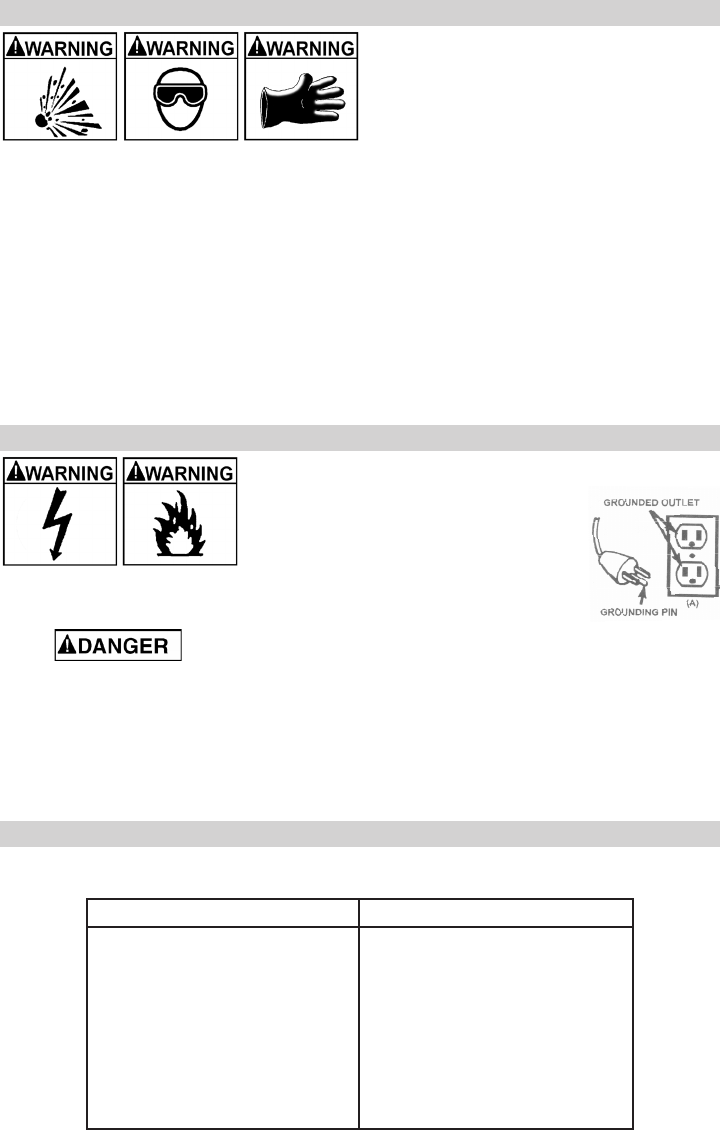
• 4 •
FOLLOW THESE STEPS WHEN BATTERY IS OUTSIDE VEHICLE7.
A SPARK NEAR THE BATTERY MAY CAUSE
A BATTERY EXPLOSION. TO REDUCE THE
RISK OF A SPARK NEAR THE BATTERY:
Check the polarity of the battery posts. 7.1
The POSITIVE (POS, P, +) battery post usually
has a larger diameter than the NEGATIVE
(NEG, N, -) post.
Attach at least a 24-inch (61 cm) long 6-gauge (AWG) insulated battery cable to the 7.2
NEGATIVE (NEG, N, -) battery post.
Connect the POSITIVE (RED) charger clip to the POSITIVE (POS, P, +) post of the battery.7.3
Position yourself and the free end of the cable you previously attached to the NEGATIVE 7.4
(NEG, N, -) battery post as far away from the battery as possible – then connect the
NEGATIVE (BLACK) charger clip to the free end of the cable.
Do not face the battery when making the nal connection.7.5
Connect charger AC supply cord to electrical outlet.7.6
When disconnecting the charger, always do so in the reverse order of the connecting 7.7
procedure and break the rst connection while as far away from the battery as practical.
A marine (boat) battery must be removed and charged on shore. To charge it onboard 7.8
requires equipment specially designed for marine use.
GROUNDING AND AC POWER CORD CONNECTIONS8.
RISK OF ELECTRIC SHOCK OR FIRE.
This battery charger is for use on a 8.1
nominal 120-volt circuit and has a grounded
plug that looks like the plug illustrated. The
charger must be grounded to reduce the risk of
electric shock. The plug must be plugged into
an outlet that is properly installed and grounded
in accordance with all local codes and ordinances. The plug pins must t
the receptacle (outlet). Do not use with an ungrounded system.
8.2 Never alter the AC cord or plug provided – if it does not t the outlet,
have a proper grounded outlet installed by a qualied electrician. An improper
connection can result in a risk of an electric shock or electrocution.
NOTE: Pursuant to Canadian Regulations, use of an adapter plug is not allowed in Canada.
Use of an adapter plug in the United States is not recommended and should not be used.
Recommended minimum AWG size for extension cord:8.3
100 feet (30.5 meters) long or less – use a 10 gauge (5.26mm•
2
) extension cord.
Over 100 feet (30.5 meters) long – use an 8 gauge (8.36mm•
2
) extension cord.
ASSEMBLY INSTRUCTIONS9.
It is important to fully assemble your charger before use. Remove all cord wraps and 9.1
uncoil the cables prior to using the battery charger. Follow these instructions for assembly.
PARTS TOOLS NEEDED
(2) 10-32, thread cutting screws
(4) ¼-20, thread cutting screws
(2) wheels
(1) axle
(2) axle caps
(2) axle brackets
(1) handle
(1) foot
3/8" wrench (for mounting foot)
5/16" wrench (for mounting wheels)
1/4" wrench (for mounting handle)
hammer
screwdriver (at blade)
screwdriver (Phillips)















